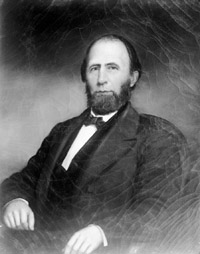By Eric Medlin, 2022
Following the Civil War, Southern Democrats lost much of their political power, but many people were unwilling to accept this change. “Redemption” was the name given to the efforts of Southern Democratic political leaders and white supremacists who worked to undo gains made by the Republican party and black people following the Civil War. “Redeemers” referred to their actions as “redemption” because they believed they were “redeeming” southern states from the “misrule and corruption” of Reconstruction and Republican political leaders. In reality, the “redemption” movement was a campaign of white supremacy and violence that dramatically changed the political landscape of North Carolina and the South during the late 1800s.
Reconstruction (1865-1877) was one of the most tumultuous periods in American history. During reconstruction, major changes in race, class, and politics occurred across the South. These changes included new legal rights and economic opportunities for millions of black Americans. This period of sudden change mandated by the Federal government led to backlash from many white Southerners. One of the ways this backlash manifested was in the “Redemption” movement. Redeemers sought to overthrow Radical Republicans in the South during and after reconstruction. The Redemption movement changed the political party in power while also reversing civil and voting rights.
Redemption came about due to a shift in attitudes towards Reconstruction-era Republican governments. Democrats never supported Radical Republicans, but early on, they would occasionally work with Republican leaders. They collaborated in building railroads. Democrats also sometimes accepted black Americans as voters and officeholders. Many native Southerners joined and worked in the Republican Party.
Some Democrats cooperated with Republicans because their attempts at opposition failed. Southern Democrats feared military control. Many of them could not vote during much of Reconstruction because their ties to the Confederacy disqualified them.
In 1866, Confederate Veterans formed the Ku Klux Klan with the intention of combatting Reconstruction and limiting the voting, political, and civic power of black people. In response, multiple branches of the Federal Government worked to limit KKK activity. During the presidency of Ulysses S. Grant, Congress passed The Enforcement Acts of 1870 and 1871. These acts were also known as the “Ku Klux Klan acts,” and they sought to limit the activities of the KKK, enforce the Fourteenth Amendment, and uphold the Civil Rights Act of 1866.
In 1875, white Southern Democratic leaders changed their tactics. They focused on what became known as the Mississippi Plan to prevent black political participation. These Democratic politicians also worked to undermine Republicans at every turn, carrying out campaigns of violence, harassment, and electoral fraud. Militant groups such as the Red Shirts took these actions with the hope that Republicans were too fractured to intervene. They were often correct. Historians David Donald and James G. Randall wrote that the Red Shirts “were no secret Ku Kluxers; they wanted the Negro and his friends to know that the entire white population of the state was against continuation of Republican rule.” One by one, Reconstruction-era governments fell to the forces of Redemption. In 1870, Democrats used fear, intimidation, and violence to take over the legislature and many local offices. The next year, North Carolina Governor William Woods Holden was impeached for supposedly violating the state Constitution in his effort to fight the Klan. Holden’s impeachment has been greatly criticized and the state legislature formally apologized for the impeachment in 2011. That year, Floyd B. McKissick, Jr., a black legislator, said that the impeachment “was repugnant in every respect... justice demands that it be reversed.”
With Holden impeached in 1871, Republicans quickly lost power at the state level. Five years later, voters elected a Democrat, Zebulon Vance, as governor. Vance had been the state’s Civil War governor and was unable to serve as an elected official until the 1872 Amnesty Act. This act removed the voting and office-holding disqualifications that the Fourteenth Amendment had placed on secessionists from the Civil War.
Reconstruction efforts decreased leading up to the presidential election of 1876. The outcome of the 1876 presidential election, one of the closest in American history, was debated for months. Finally, in return for handing the presidency to a Republican, the Republican Party agreed to remove federal troops from the South. With that act, Reconstruction was over.
Once the Democratic Party regained power in North Carolina in the early 1870s, it spent the next decade overturning much of the legacy of Reconstruction. Democratic officials restricted social spending, overturned advances in education, and restored older, less democratic forms of county government. In addition, they continued to tamper with elections and intimidate voters at election time. The policies of Redemption eventually led to the restrictions on voting and civil rights that became known as Jim Crow.
Governor David Lindsay Russell was a one-term Republican governor of North Carolina elected during the reign of the Democratic Party. He served from 1897 to 1901, but he would be the only Republican elected to the position for 72 years. North Carolina did elect another Republican governor in 1973 in James Hollhouser, Jr. By the time of Hollhouser’s election, there had been a significant shift in party ideals and motives, and the parties of the mid-1900s barely resembled their post-Civil War counterparts. The party shift can be found in the 1966 U.S. House of Representatives race for North Carolina’s Fourth District between Jim Gardner and Harold Cooley.
One of the few areas in which Redemption continued the legacy of Reconstruction was government support of industry. Southerners became focused on industrial growth and building railroads. New factories, towns, and schools were built. Because of Redemption, these projects were hindered by segregation and a culture of violence. The system of segregation imposed after Redemption lasted for nearly 100 more years and did considerable harm to people, the state, and the American South.
References:
Barnett, Ned. “N.C. state senate pardons governor who stood up to Klan.” Reuters, April 12, 2011, https://www.reuters.com/article/us-northcarolina-pardon/n-c-state-senate....
Foner, Eric. Reconstruction: America’s Unfinished Revolution, 1863-1877. New York: Harper and Row, 1988, 562-563.
Hild, Matthew. “Redemption.” New Georgia Encyclopedia. July 21, 2020. https://www.georgiaencyclopedia.org/articles/history-archaeology/redempt....
Randall, J.G. and David Herbert Donald. The Civil War and Reconstruction. Boston: Little, Brown, and Co, 1969.
The National Park Service. The Era of Reconstruction, 1861-1900. U.S. Department of the Interior, July 28, 2017. http://www.npshistory.com/publications/nhl/theme-studies/reconstruction-....


